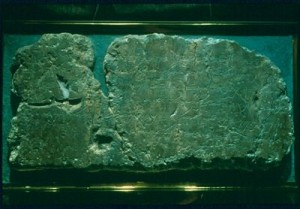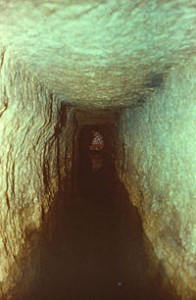 Bringing Water Inside Jerusalem’s Walls
Bringing Water Inside Jerusalem’s Walls
When Hezekiah saw that Sennacherib had come, intent on making war against Jerusalem, he consulted with his officers and warriors about stopping the flow of the springs outside the city, and they supported him. (2 Chronicles 32-2-3)
Translation- [The day of] the breach. This is the record of how the tunnel was breached. While [the excavators were wielding] their pickaxes, each man toward his co-worker, and while there were yet three cubits for the brea[ch,] a voice [was hea]rd each man calling to his co-worker; because there was a cavity in the rock (extending) from the south to [the north]. So on the day of the breach, the excavators struck, each man to meet his co-worker, pick-axe against pick-[a]xe. Then the water flowed from the spring to the pool, a distance of one thousand and two hundred cubits. One hundred cubits was the height of the rock above the heads of the excavat[ors.]
Date- 701 BCE
Current Location- Istanbul Archaeological Museum, Istanbul, Turkey
Language and Script- Biblical Hebrew; alphabetic
Biblical Verses- 2 Kings 20-20; 2 Chronicles 32-1–4, 30
General Information-
In discussing the building achievements of King Hezekiah, the Bible mentions a tunnel that he had dug under the City of David in Jerusalem to supply water to the upper part of the city. The Siloam Inscription that was found in the tunnel is arguably the most precious of all ancient Hebrew inscriptions. It seems to have been privately commissioned by the tunnel’s chief engineer, in whose voice it describes the completion of the digging. Initially, two crews of workmen dug simultaneously from opposite ends of the projected tunnel. The inscription records that as the two teams of tunnelers came within about five feet of each other they realized that they had gone slightly off course and would not meet. The workmen relied on the sound of their pickaxes and their voices to correct the trajectory to join the two parts of the tunnel. The meeting point is visible as a series of irregular cuts near the tunnel’s midpoint. Strangely, the inscription filled only the lower half of a rectangular area of carefully smoothed stone. Perhaps the empty upper portion was prepared for another inscription or for a relief sculpture depicting an aspect of the tunnel’s construction.
Relevance to Ancient Israel- Although the Siloam Inscription does not refer to King Hezekiah or another known person or event, the tunnel was almost certainly constructed during his reign. The eighth-century BCE dating of the inscription is confirmed by the style of the letters (paleography) and the distinguishing elements of grammar and spelling. This inscription is of utmost importance in countering the claims of those who deny the significance of the Monarchic Period and the Bible’s account of it. Unfortunately, no other monumental Hebrew inscription from the pre-Exilic period has come to light yet.
Circumstances of Discovery and Acquisition- The inscription was discovered in 1880 by boys playing near the southern end of Hezekiah’s Tunnel. Although it was naturally carved into the tunnel wall, thieves chiseled it out of the wall, breaking it in pieces. Eventually, they came into the possession of a Jerusalem antiquities dealer. At that time, Palestine was controlled by the Ottoman Turkish Empire, which confiscated the inscription from the dealer and sent it to the Istanbul Archaeological Museum. It is currently on display there.
See also:
- Queries and Comments- Who Chiseled Out the Siloam Inscription? BAR 10-05, Sep-Oct 1984.
- W.A. Khayat to Sir W. White- The Theft of the Siloam Inscription, Mordechai Eliav, Britain and the Holy Land- 1838-1914, Jerusalem, 1997.
- The Village of Siloam
- The City of David
- The Assyrian Siege, NOVA.
- The Tombs of Silwan, Hershel Shanks, BAR 20-03, May-Jun 1994.
- Rewriting Jerusalem History, Hershel Shanks, BAR 25-06, Nov-Dec 1999.
- Lasting Impressions, Robert Deutsch, BAR 28-04, Jul-Aug 2002.
- Strata- King Hezekiah Did Build the Tunnel, BAR 29-06, Nov-Dec 2003.

